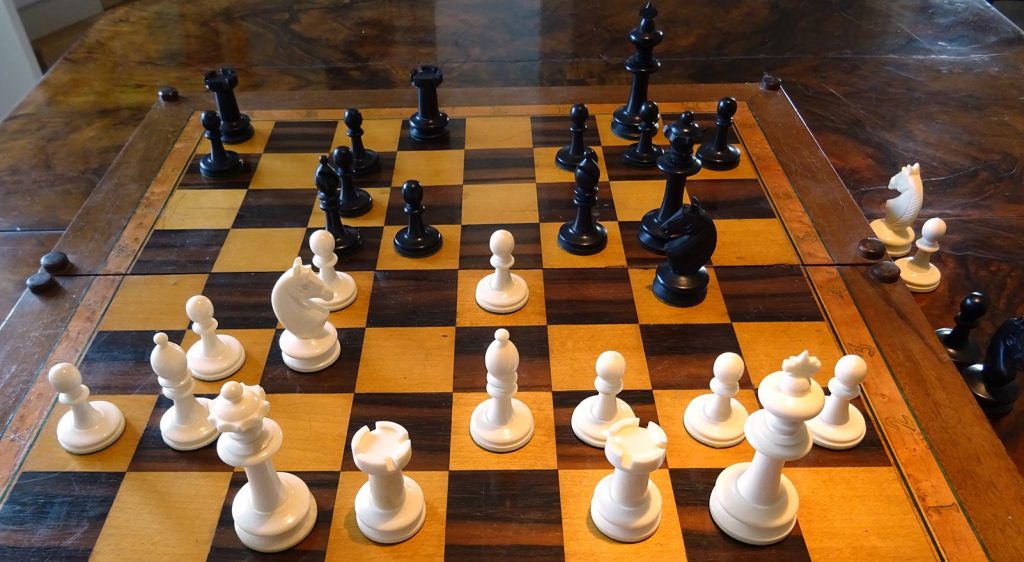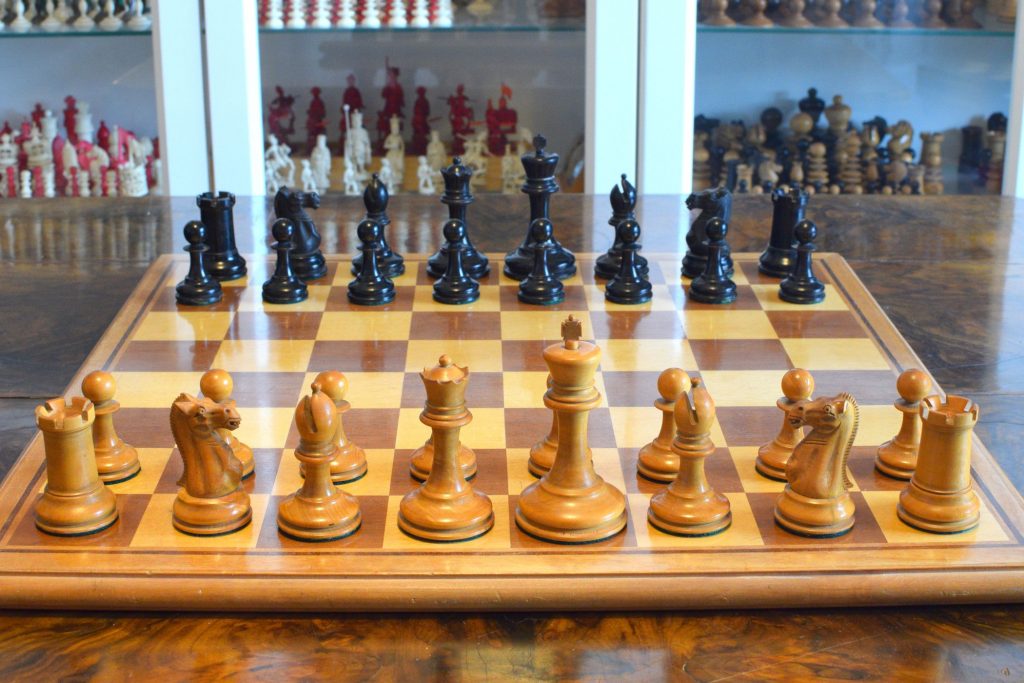
In the last couple of months, racism all over the world has rightfully received an increased attention. We are still far away from a society in which people have equal chances irrespective of their gender, age, physical condition or skin colour. It did not take long – and was to be expected – that the discussion was sparked again, whether chess is promoting racism as well. A friend of mine, who does not have any personal connection to chess, but who knows of my love for antique chess sets, just made me aware of a news clip on this topic. So I gave it some thoughts and spontaneously wrote this little article.
The reason for the discussion is simple: we are playing chess (nowadays) with white pieces against black pieces with white moving first. Apparently, the recent discussion rekindled with a Sydney radio show had arisen out of a tweet by a father who said he had wondered whether chess rules had racist origins after he was asked by his daughter why white always moved first.
It was perfectly alright for the daughter asking this question. The question is, whether the answer should be “yes”? In my view this would be a bit too simple.
The discussion resulted in several articles that tried to fathom the origin of the rule that white goes first. I do not want to elaborate on this, but would rather refer to some of the articles already written on this topic, such as this thoroughly researched article by Daaim Shabazz.
To some the notion of chess being racist because of the black & white pattern of the game was ridiculous and was objected, e.g. by Garry Kasparov.
Of course, one can ask, if white has a significant advantage if starting. Analysis would be more complicated, if black started, because we are used to a fixed system and setup in which the white side moves first and we would need to adapt chess theory if black were to start. But it is possible without a doubt, as Magnus Carlsen and Anish Giri were showing.
But what we heard so far is a mere perspective reflecting on the game of chess itself. What in my view is missing until today is the question, whether the above theory is also supported by the historical development of the playing material. In other words, what is the origin of black playing white in chess? Was this always the case? The quick answer is “no”, which is why I have problems following the simplified approach of calling chess a racist game.
The exact origin of chess is not entirely clear. Theories that saw the origin in China are now probably disproved. Approaches that see the origin in India still have many supporters today. For example, one of the basic rules of chess, namely that the king may not be captured, is said to have its origin in the post-Vedic doctrine of the divinity of the king. The colours used in India at that time to distinguish the chessmen of the two sides were green and red. This colour combination is still in use in traditional Indian chess pieces to this day.

In the meantime, however, possibly stronger arguments suggest that chess actually did not originate in India but in Iran. In Iranian chess pieces, however, such green or red coloured pieces could not be found. Rather, the Persian epic Shahnameh (شاهنامه) mentions the nature of chess pieces on several occasions. The Shanameh is one of the most famous and, with more than 50,000 verses, most extensive works of Persian literature. It was written around 1010 AD by the Persian poet Abu ʼl-Qasim Firdawsi. Firdawsi essentially reproduces the contents of the Chatrang-namak, the “Chess Book”, a Middle Persian text that tells how chess arrived at the Iranian court from India (which according to modern research may well be fiction rather than fact, see above).
The relevant passages explicitly mention wooden chess pieces. Edmond and Arthur George Warner have translated these passages of the Shanameh into English as follows:
„They set the board and men before the Sháh,
Who looked upon the pieces for a while.
Half of the set was made of ivory
And bright, the other half of teak.”
At a later point it says:
„Those men of wisdom called for ebony,
And two of them – ingenious councillors –
Constructed of that wood a board of foursquare
To represent the trench and battlefield,
And with both armies drawn up face to face.
A hundred squares were traced upon the board,
So that the kings and soldiers might manoeuvre.
Two hosts were carved of teak and ivory,
And two proud kings with crowns and Grace divine.”
This indicates that the pieces given to the Iranian ruler were made of ivory and teak, i.e. white and dark brown. So it could well be that this was the origin of the colour combination of white and black that is still common today (a view, inter alia, expressed by Deborah Freeman Fahid, Chess and Other Games Pieces from Islamic Lands, London 2018, p. 65).
Nevertheless, chess pieces have by no means always been black and white. In the 18th and 19th century, in particular in English and French ivory sets, a very common combination was red and white. The reason for this was, inter alia, the use of cochenille, which was required for the red dye of the pieces and which at that time was by far the most exclusive dye in the world. It represented a certain value thus showing the wealth of its owner.

For wooden pieces hard wood was used, boxwood for the white pieces and ebony or rosewood for the black pieces. The latter were valuable materials and both rather dark in colour, but at the same time extremely dense and as such particularly suitable for turning and polishing. If viewed realistically, ebony can be described as black, but boxwood is not white, rather light brown.

In the course of the 19th century chess became more of a sport and competition while at the same the wealthy members of society discovered the pleasures of pastime, which they increasingly spent with chess. Books on the topic were published in increasing number and chess problems and puzzles were solved in coffee houses. Printing however was done in black ink letters on white paper, increasing the notion of chess being played in white vs. black.
I am not going so far as to say that chess is free from racism. There were chess sets that from today’s perspective are clearly depicting racist views, such as chessmen, in which the opposite parties are, for example, shown as Christians vs. Moors. But neither were these types of sets widespread nor is this in my view a comprehensible reason for the white & black pattern in chess.

The opposing colours of black and white have a very diverse meaning in society. Among others they are symbolizing good and evil, night and day etc. In particular the latter is showing a very practical relevance. Night is characterised by the absence of light, day is the presence of light. Just as black letters are better visible against a white background, black pieces are easier to distinguish from white pieces than dark brown pieces from light brown. Some chess authors therefore tend to talk of the light pieces and the dark pieces rather than black and white, which is probably a better and more realistic approach. Nevertheless, I find it personally difficult to establish a connection between the black & white colour pattern of chess on the one hand and racist notions on the other. So let’s make the world a better place by abolishing all means of racism in everyday life, but let’s not artificially construe racist notions where no grounds can be substantiated. It is not helping the good cause, but is only diverting from the real issues, of which there are still many!

